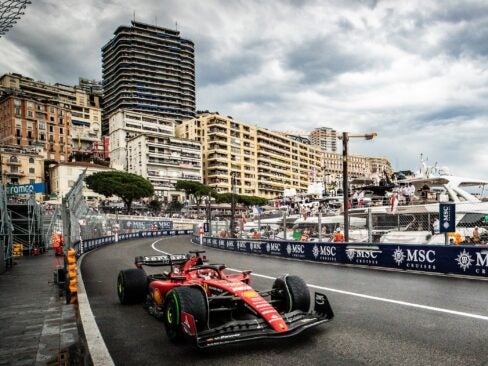This story originally appeared in the March/April 2018 issue of Elite Traveler.
Head of his own eponymous watch brand, Richard Mille has adventure in his soul. Not only did this entrepreneur build one of the most successful independent timepiece firms of the past two decades, but he also pioneered the way to new high-tech watch materials and was the first to insist that all brand ambassadors wear his $100,000+ watches while in play on the tennis courts, golf courses and F1 circuits. Here, he shares his insights with Elite Traveler’s Roberta Naas on how he maneuvered his way to the top when everyone said it couldn’t be done.
 It was in 1999, after a 25-year-long journey in the watch industry working for several brands, that the now-67-year-old Richard Mille broke from the mold and started his own watch brand. A businessman rather than a watchmaker, Mille’s plan, he says, was a cautious one in terms of numbers, but a very bold one in terms of product design and development. In fact, his avant-garde, architecturally inspired watches are still turning heads and breaking records nearly 20 years later.
It was in 1999, after a 25-year-long journey in the watch industry working for several brands, that the now-67-year-old Richard Mille broke from the mold and started his own watch brand. A businessman rather than a watchmaker, Mille’s plan, he says, was a cautious one in terms of numbers, but a very bold one in terms of product design and development. In fact, his avant-garde, architecturally inspired watches are still turning heads and breaking records nearly 20 years later.
“I always say that if I had been a watchmaker, I never would have made the type of watches I now make because I would not have thought it possible,” says Mille. “My watches are a synthesis, or symbiosis, of my love for cars, aircraft and anything mechanical and technical. I have always also had a deep love of architecture and design. So I combine them in my watches to give them a strong personality, a good identity and ensure they are light and ergonomic so they will be a good companion to life.”
 According to Mille, when he started his company — teaming with Renaud & Papi for his tourbillon and high-complication movements — he was happy to be on the way to building something very different, despite the fact that most of his friends said he would not succeed. “At the very beginning, everyone was taking bets against me. Many of my friends thought that my ideas were just too crazy and too pioneering in spirit and materials,” says Mille. “But while I had a bold plan for the watches, I also had a conservative business plan from the numbers side. I knew my prices would be extremely high, so in the beginning I was content to sell a few tens of pieces a year. I thought that would be fantastic for me,” says Mille, further noting that his firm produced 4,000 watches in 2017.
According to Mille, when he started his company — teaming with Renaud & Papi for his tourbillon and high-complication movements — he was happy to be on the way to building something very different, despite the fact that most of his friends said he would not succeed. “At the very beginning, everyone was taking bets against me. Many of my friends thought that my ideas were just too crazy and too pioneering in spirit and materials,” says Mille. “But while I had a bold plan for the watches, I also had a conservative business plan from the numbers side. I knew my prices would be extremely high, so in the beginning I was content to sell a few tens of pieces a year. I thought that would be fantastic for me,” says Mille, further noting that his firm produced 4,000 watches in 2017.
“From the beginning I always thought that the high-end watch business was a bit boring and that made me want to be more adventurous,” says Mille. “I wanted to be open to the world of sports, of art, lifestyle and women. I said that would be my focus, and when I say something, I do it.”
 In order to create a watch that could go the distance in the sports world, Mille invested a great deal of time and money into research and development, and was one of the first to go outside the watch world to look for high-tech materials that could withstand constant shock and wear and tear.
In order to create a watch that could go the distance in the sports world, Mille invested a great deal of time and money into research and development, and was one of the first to go outside the watch world to look for high-tech materials that could withstand constant shock and wear and tear.
He was the first in the world of watchmaking to alter carbon with NTPT (North Thin Ply Technology) and TPT. To date, he has developed some of the most famous watches of the past two decades, including the RM 008 Tourbillon with split-seconds chronograph and torque indicator, which was introduced in 2005 and quickly sold out. Considered one of the most technically advanced watches in the world, it carried a retail price of $455,000 in titanium. Similarly, his RM 056 split-seconds chronograph tourbillon watch was the first to have a three-part, completely sapphire case that one could see right through. A version dedicated to race car driver Felipe Massa, the RM 056 Sapphire — sold out today — retailed for $1.98m. Just this past year, Mille made history with the million-dollar RM 50-03 McLaren F1 Split-Seconds Tourbillon Chronograph watch, the lightest split-seconds chronograph in the world, weighing in at just 40 grams. Indeed, the list of firsts for this brand goes on and on.
 “One of the biggest challenges I had when I first launched the brand was that I wanted my brand ambassadors to wear their watches in play. They would say to me, ‘It is impossible to play golf or tennis with a watch.’My objective was to make the two worlds work together — the world of extreme complexity and fragility that is watchmaking, and the world of endurance, resilience and impact that is sports.”
“One of the biggest challenges I had when I first launched the brand was that I wanted my brand ambassadors to wear their watches in play. They would say to me, ‘It is impossible to play golf or tennis with a watch.’My objective was to make the two worlds work together — the world of extreme complexity and fragility that is watchmaking, and the world of endurance, resilience and impact that is sports.”
Mille admits there was a lot of trial and error, especially when he asked Spanish tennis player Rafael Nadal to wear a specially made Richard Mille watch during play. “The first watch he wore, he broke,” says Mille. “And a bunch more broke, too. It was my proving ground. It was a great challenge to learn why the watches broke and to be obliged to go higher and higher in the resistance and the materials until it was perfect. For me, every time you are challenged with extreme conditions and you conquer the problem, you win a lot of legitimacy. I am not afraid to say that in the world of watches we are experienced in all parameters and configurations for sports performance, shock resistance, light weight and comfort.”
 As initially planned,Mille insists that all of his brand ambassadors — and there are many — wear their watches in play. Today, Nadal continues to be a brand ambassador, as are Olympic-medal sprinters Yohan Blake and Wayde van Niekerk, golfer Bubba Watson, F1 drivers Felipe Massa and Romain Grosjean, and others. Mille has even created watches in honor of many of his brand ambassadors. This past year alone, he unveiled the $815,000 RM70-01 Tourbillon Alain Prost and the $725,000 RM 27-03 Tourbillon Rafael Nadal.
As initially planned,Mille insists that all of his brand ambassadors — and there are many — wear their watches in play. Today, Nadal continues to be a brand ambassador, as are Olympic-medal sprinters Yohan Blake and Wayde van Niekerk, golfer Bubba Watson, F1 drivers Felipe Massa and Romain Grosjean, and others. Mille has even created watches in honor of many of his brand ambassadors. This past year alone, he unveiled the $815,000 RM70-01 Tourbillon Alain Prost and the $725,000 RM 27-03 Tourbillon Rafael Nadal.
“It is important for them to wear their watches in real life,” says Mille. “So many marketing campaigns seem artificial and superficial. Ambassadors put the watch on after play, for the trophy or the photos, and to me that is a bit fake. I want to show that my watches are not just objects for show, but legitimate extreme watches for extreme conditions.”
According to Mille, the biggest challenge he had in building his company came in the very first year. He was releasing a watch with a torque indicator that was supposed to be delivered for the year 2000. “It was not working properly. I could have delivered it on time and had repairs come back, but I didn’t want to do that. It is hard to know you are going to lose an entire year just coming out on the market, but it was something I had to go through. And after one year, I was pleased to deliver the piece with fantastic quality. It was tough, but it prepared me. In fact, honestly, I was prepared to do worse than I have done.”
Between his love of powerful design, pioneering technology and establishing an incredible identity for his watches, one might wonder where Mille finds the time to run his business. He is busy working with research and development strategists, partnering with auto and aircraft companies, as well as ambassadors, and running the numbers to ensure success.
“For me, it is all about having both parts of my brain involved. I love to be crazy and creative, and I also love numbers. I love to see a P&L statement, a balance sheet, because I know how many pieces we need to build and what sells and doesn’t. We control the production, the volume, the margins, and I love that,” says Mille, admitting openly that he is a control freak. “I try to cure myself of being the biggest control freak ever by taking some time and distance in certain steps, but I have a great team, too, and I trust them to do the job right.”
So, according to Mille, what does it take to create a truly successful business? “Passion and reasonable common sense,” says Mille. “You must be very free in your thinking, very realistic in your vision and numbers, and very in-tune with the markets globally. It is a complex system of completeness to be as perfect as possible. Patience is key, and you must have total control of your nerves.”
Images: Richard Mille; detail of the RM 50-03 McLaren F1; side view of the RM 50-03; detail of the RM 27-03 Tourbillon Rafael Nadal; side view of the RM 27-03









